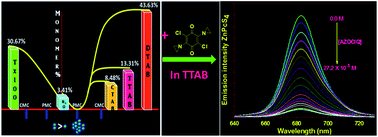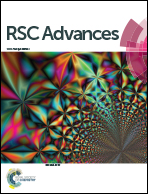Aggregation–disaggregation pattern of photodynamically active ZnPcS4 and its interaction with DNA alkylating quinone: effect of micellar compactness and central metal ion†
Abstract
The hypoxic nature of solid tumours and the aggregation of photosensitizers in physiological environments are two governing limiting factors in photodynamic therapy (PDT). This article describes the effect of sensitivity to polarity and the central metal ion on the aggregation–disaggregation pattern of the PDT-active metallophthalocyanine ZnPcS4 and its relevant interaction with a DNA alkylating quinone in an aqueous medium, as well as in a biomimicking micellar microenvironment, under hypoxic conditions to overcome the limitations of PDT. Steady-state absorption and emission, time-resolved fluorescence (TRF), fluorescence anisotropy and dynamic light scattering (DLS) techniques were employed for this purpose. Similarly to AlPcS4, the spectral behaviour of ZnPcS4 remains immune to anionic SDS and also displays a significant interaction with the positively charged head group of cationic surfactants (DTAB, TTAB, and CTAB). In the premicellar region, surfactant-induced aggregation of the probe molecules is dominant. Above the critical micellar concentration (CMC), AlPcS4 fully disaggregates into monomers but the tendency of ZnPcS4 to undergo monomerization increases with a decline in the compactness of cationic micelles. The increase in the fluorescence anisotropy of ZnPcS4 in a fully micellized system upon reducing the compactness of the micelles confirms deeper penetration of the dye inside the micelles, a behaviour which is the reverse of that of AlPcS4. The latter remained resistant in neutral micelles, whereas ZnPcS4 substantially monomerized on an increase in the TX-100 concentration and distributed itself at the shear surface and in the deeper hydrophobic core of a fully micellized system. Dye-induced formation of micellar clusters was identified by DLS measurements, especially in cationic micelles. The interaction of PDT-active ZnPcS4 with DNA alkylating 2,5-dichlorodiaziridinyl-1,4-benzoquinone (AZDCIQ) was studied in an aqueous medium, as well as in all the micellar microenvironments under study, and found to be more prominent in cationic micelles compared with the other systems. However, the association constants (Ka) thus obtained in the cationic micelles were found to be greater for ZnPcS4 than for AlPcS4. Our findings may prove instrumental in expanding the effectiveness and applicability of metallophthalocyanines in terms of understanding their aggregation pattern and interaction with DNA alkylating quinones in a hypoxic micellar microenvironment.


 Please wait while we load your content...
Please wait while we load your content...